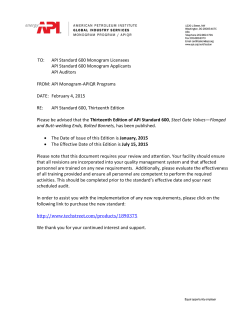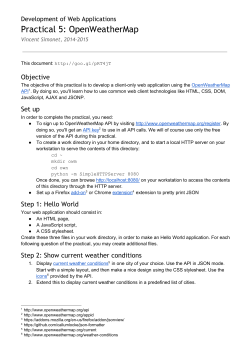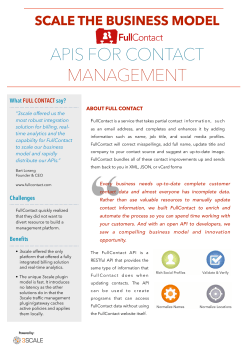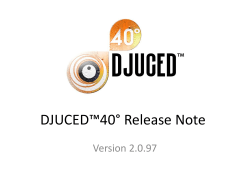
Attachment 31 - 17G3 Task Group Status Report
API C2 / SC 17 SUBCOMMITTEE ON SUBSEA PRODUCTION SYSTEMS API 17G3 Light Duty Intervention System (LDIS) REVISION TASK GROUP STATUS 1.9.2015 API 17G3 – LIGHT DUTY INTERVENTION SYSTEM WINTER MEETING STATUS REPORT 1. INTRODUCTION Include in this update is the status of API 17G3 and a summary of the new direction agreed in August, 2014. 2. STATUS A draft LDIS design flow chart was distributed for review. No comments received outside of the API 17G meeting in Galveston in August, 2014. 3. MEMBERSHIP TABLE 1-1: API RP17W TASK GROUP MEMBERS Name Company E-Mail Address Mike Swift Hess Corporation mswift@hess.com Mike Hess Shell michael.hess@shell.com Mirick Cox ExxonMobil mirick.t.cox@exxonmobil.com Paul Beauchamp NOV paul.beauchamp@nov.com Lalit Karlapalem NOV lalit.karlapalem@nov.com Ryan Schmidt FMC Technologies ryan.schmidt@fmcti.com Espen Holm FMC Technologies espen.holm@fmcti.com Tore Geir Wernø Alastair Buchanan Statoil Statoil TGW@statoil.com Joe Savoy Wild Well Control jsavoy@wildwell.com Jamie Walker Expro Group jamie.walker@exprogroup.com Paul Deacon Expro Group paul.deacon@exprogroup.com Derek Ferguson Expro Group derek.ferguson@exprogroup.com Bill Cowan ENI bill.cowan@enipetroleum.com Thomas Box Tetra Technologies tbox@tetratec.com Virgilio Garcia Tetra Technologies vgarcia@tetratec.com Mitch Dziekonski Titanium Engineers mitch@titaniumengineers.com Oskar Kudla BP Oskar.Kudla@bp.com Bill Parks DTC International bill.parks@dtc-houston.com Khoa Pham alabuc@statoil.com -1- [Date] API 17G3 – LIGHT DUTY INTERVENTION SYSTEM WINTER MEETING STATUS REPORT 4. MAJOR ISSUES API 17G3 is different from G2 (subsea pumping) and G4 (riserless intervention) in that it is a pipe based system. Deviation from API 17G, for a pipe based system, should only come in the form of reduced application if API 17G functionality is removed for simplification. The challenge 17G3 is facing is the volume of applications and configurations one could dream up for a Light Duty Intervention System. Light Duty Intervention System, by name, is light. It is a pipe based system designed with reduced functionality for a specific use or application. The whole of API 17G may not apply to LDIS, but there are minimum 17G requirements that must be followed. A design flow chart was proposed as a way to guide designers, manufactures and operators to a set of minimum requirements when specifying a LDIS. After thinking about this further, a design flow chart is nothing more than an applied safety strategy which the current 17G requires. This direction was proposed to API 17G members during the August, 2014 meeting in Galveston. It was unanimously accepted. API 17G3 should document an example, common application, such as executing a through-tubing intervention with wireline only by using the 17G safety strategy in the form of a design flow chart. The method can then be applied to any application or system configuration. -2- [Date] API 17G3 – LIGHT DUTY INTERVENTION SYSTEM WINTER MEETING STATUS REPORT 5. ANTICIPATED NEW WORK ITEMS Below is an example flow chart that was reviewed during August, 2014 meeting. -3- [Date] API 17G3 – LIGHT DUTY INTERVENTION SYSTEM WINTER MEETING STATUS REPORT 6. PLANS FOR FUTURE MEETINGS Review the design flow chart method for specifying LDIS for a specific application and determine if this direction is useful for the industry. 7. RESOURCE NEEDS Participation has dropped off. Resources from manufactures and end users are needed to mature the example design flow chart and bring this effort to an end. -4- [Date]
© Copyright 2025









